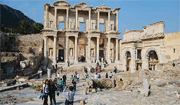This program has a new location.
For a brief, dazzling moment, Ravenna was an unlikely refuge for a world falling apart. The city’s history, enshrined in superb Byzantine mosaics, reflects the twilight of the Roman Empire and the beginning of the Middle Ages. While ageless monuments were falling everywhere, Ravenna was crowded with new and sumptuous palaces and monuments. As the capital of the Western Roman Empire in its last days, then of the occidental provinces of the Byzantine Empire, it offered a refuge of luxury and splendor, a return to antique civilization rising above the relentless waves of Barbarians.
Art historian Elaine Ruffolo highlights the history of this city, its important architecture, and the extraordinarily decorative complexes of its churches—masterpieces of an age when artistic achievement was reaching one of its summits in the form of mosaics. UNESCO has recognized the “outstanding universal value” of Ravenna’s early Christian buildings, citing “the supreme artistry of the mosaic art that the monuments contain” and “the crucial evidence that they provide of artistic and religious relationships and contacts at an important period of European cultural history.”
Ruffolo is a lecturer for Syracuse University’s academic program in Florence.
Other Connections
Learn more about how and why UNESCO added Ravenna’s early Christian monuments to its World Heritage List, and see some examples of the buildings and mosaics that helped secure that designation.
 Explore the history of the Mediterranean, Ionian, and Adriatic shores on tour—A Cruise from Istanbul to Venice: Historic Cities of the Sea.
Explore the history of the Mediterranean, Ionian, and Adriatic shores on tour—A Cruise from Istanbul to Venice: Historic Cities of the Sea.
Visit the Smithsonian Journeys page to see more
European trips.